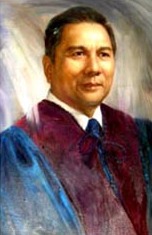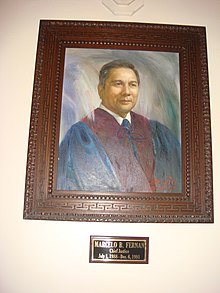Marcelo Fernan
This articleneeds additional citations forverification.(February 2021) |
Marcelo Fernan | |
|---|---|
 | |
| 16thPresident of the Senate of the Philippines | |
| In office July 27, 1998 – June 28, 1999 | |
| President | Joseph Estrada |
| Preceded by | Neptali Gonzales |
| Succeeded by | Blas Ople |
| 18thChief Justice of the Philippines | |
| In office July 1, 1988 – December 6, 1991 | |
| Nominated by | Corazon Aquino |
| Preceded by | Pedro Yap |
| Succeeded by | Andres Narvasa |
| 111thAssociate Justice of the Supreme Court of the Philippines | |
| In office April 9, 1986 – June 30, 1988 | |
| Nominated by | Corazon Aquino |
| Preceded by | Lorenzo Relova |
| Succeeded by | Florenz Regalado |
| Senator of the Philippines | |
| In office June 30, 1995 – July 11, 1999 | |
| Member ofRegular Batasang PambansafromCebu City | |
| In office June 30, 1984 – March 25, 1986 Serving withAntonio Cuenco | |
| Member of the Cebu Provincial Board | |
| In office December 30, 1959 – December 30, 1961 | |
| Personal details | |
| Born | Marcelo Briones Fernan October 24, 1927 Cebu,Cebu,Philippine Islands |
| Died | July 11, 1999(aged 71) Manila,Philippines |
| Political party | LDP(1991–1999) UNIDO(until 1986) |
| Relations | Manuel Briones(uncle) Matteo Guidicelli(grand-nephew) Sarah Geronimo(great-niece-in-law) |
| Alma mater | University of the Philippines Diliman(LL.B) Harvard University(LL.M) |
Marcelo"Celing"Briones Fernan(October 24, 1927 – July 11, 1999) was a Filipino lawyer and political figure. He is the only Filipino to have served as bothChief Justiceof theSupreme Courtand as Senate President. He is also the third Filipino to have headed both the judicial and legislative branches of government, afterQuerube Makalintalwho served asChief Justiceand Speaker of theBatasang Pambansain the 1970s, andJosé Yulo,who served as Chief Justice and Speaker of the House of Representatives before 1946.
Early life[edit]
Fernan was born inCebu,Cebu in 1927. In 1953, he graduated with a degree in law from theUniversity of the Philippines.He went toHarvard Universityin United States to obtain his master's degree. He returned to the Philippines soon after to finally serve his profession as a lawyer, particularly in his home province. Soon, he became a litigator, a trial court lawyer.
Career[edit]
Early legislative career[edit]
In 1959, he was elected to theCebuProvincial Board and served until 1961. He was also elected to the 1971 Constitutional Convention as a delegate from his home province and actively participated in its sessions, and committee meetings/hearings for the formulation of a new Constitution for the country then. In 1984, during the Marcos regime, he was elected to theRegular Batasang Pambansa,then the country's unicameral parliament withAntonio Cuenco,representing the at-large district of Cebu City under the banner of the opposition UNIDO party and actively scrutinized the bills presented by the administration lawmakers and delivered privilege speeches against the Marcos regime. On 1986, after the snap elections, he was the one of the opposition lawmakers who walked out when the administration lawmakers after a canvassing session that was then filled with debates and tensions, proclaimed then PresidentFerdinand E. Marcosand his running mate, then former SenatorArturo Tolentinoas the winners of that year's snap presidential and vice presidential polls in which the opposition claimed was marred with fraud.
Judicial[edit]

In 1977, he was elected national president of theIntegrated Bar of the Philippines,the country's national organization of lawyers.
After the People Power Revolution and the dissolution of the Batasang Pambansa, he was appointed by PresidentCorazon Aquinoas an Associate Justice of theSupreme Courtand served until 1988 and acted also as Chairman of the Supreme Court Committee on the Revision of the Rules of Court and Chairman of the House Electoral Tribunal.
He was then promoted in 1988 as Chief Justice, the highest position of leadership in the Supreme Court and the judiciary and was Chairman of the Judicial and Bar Council, the country's screening body of the potential judges and justices and the Judiciary Planning and Implementation Office. During his term as Chief Justice, several bold judicial reforms were instituted, among them the judicial orientation and career enrichment program, updating of the Code of Judicial Conduct and the continuous trial program.
Presidential bid[edit]
He resigned as Chief Justice in 1991 to run aspresidentof the country. He later accepted the offer of House SpeakerRamon Mitraas his vice presidential candidate of theLaban ng Demokratikong Pilipino.He was the first former Chief Justice to run for vice president. In the1992 elections,however both lost toFidel RamosandJoseph Estrada,respectively.
Senate (As Senator, 1995-99 and Senate President, 1998-99)[edit]
In the1995 elections,Fernan ran for theSenateunder theLakas-Labancoalition and was elected, his fourth time entrance in politics and was named as the Assistant Majority Leader and Chairman of the Senate Committee on Justice and Human Rights as well as the Chairman of the Senate Committee on Labor, Employment and Human Resources Development for the Tenth Congress (1995-1998) and authored several significant bills that became laws of the country, among these are: Republic Act 8246 or the Court of Appeals Regionalization Act, RA 8493 or the Speedy Trial Act of 1998, RA 8557 of the Philippine Judicial Academy, RA 8525 or the Adopt-a-School Act of 1997 and RA 8558 or the Underground Mine Workers Act.
He also sponsored RA 8247 or the Alien Social Integration Act of 1995. RA 8282 or the Social Security Act of 1997, and RA 8369 or the Family Courts Acts of 1997.
Fernan was elected Senate President, the top post of leadership in the Senate, and concurrently, the Chairman of the Commission on Appointments, a congressional body tasked to scrutinize and confirm presidential appointments at the opening of the11th Congressin 1998. Under his leadership as Senate President, the Senate passed the Clean Air Act, the Visiting Force Agreement and the General Appropriations Act of 1999 and other various laws.
Death[edit]
Fernan resigned the Senate presidency on June 28, 1999, due to failing health.[1]He was succeeded in his position by Senate President pro tempore,Blas Ople.Fernan became an ordinary senator and attended committee hearings and meetings and plenary sessions even in a wheelchair but died of cancer days later, on July 11 inManila.He was buried inCebu City.TheMarcelo Fernan Bridge,the second bridge that connectsMandaue CitytoMactan Island,was named after him.
Personal life[edit]
He was married to Eloisa Nolasco in 1955, having 9 children[2]and 18 grandchildren. One daughter, Milagros Fernan-Cayosa became a member of theJudicial and Bar Council[3]from 2011 to 2019. He is also a grand-uncle to TV and movie personalityMatteo Guidicelli.[citation needed]
Trivia[edit]
He is the only Filipino who has headed both the Judiciary as Chief Justice and Legislative Branch as Senate President. For weekends, he loved bringing his family to the beaches in Mactan, Cebu and Bogo to snorkel or to ride a pump boat to visit nearby islands. Marcelo Fernan loved to sing and among his favourite songs were "Feelings" and "Matud Nila".
See also[edit]
References[edit]
- ^"DID YOU KNOW: 20th death anniversary of Marcelo Fernan".INQUIRER.net.July 11, 2019.RetrievedFebruary 25,2021.
- ^"Marcelo B. Fernan".Senate of the Philippines.RetrievedFebruary 25,2021.
- ^"Aquino reappoints Fernan-Cayosa to JBC".Inquirer.net.August 9, 2015.RetrievedSeptember 28,2022.
External links[edit]
 Media related toMarcelo Fernanat Wikimedia Commons
Media related toMarcelo Fernanat Wikimedia Commons- Senate of the Philippines - Mercelo Fernán biography
- 1926 births
- 1999 deaths
- Deaths from cancer in the Philippines
- Chief justices of the Supreme Court of the Philippines
- Associate Justices of the Supreme Court of the Philippines
- Presidents of the Senate of the Philippines
- Senators of the 11th Congress of the Philippines
- Senators of the 10th Congress of the Philippines
- Members of the House of Representatives of the Philippines from Cebu City
- Members of the Cebu Provincial Board
- Candidates in the 1992 Philippine vice-presidential election
- Harvard Law School alumni
- Centro Escolar University alumni
- People from Cebu City
- People from Bogo, Cebu
- 20th-century Filipino judges
- University of the Philippines alumni
- Members of the Batasang Pambansa



